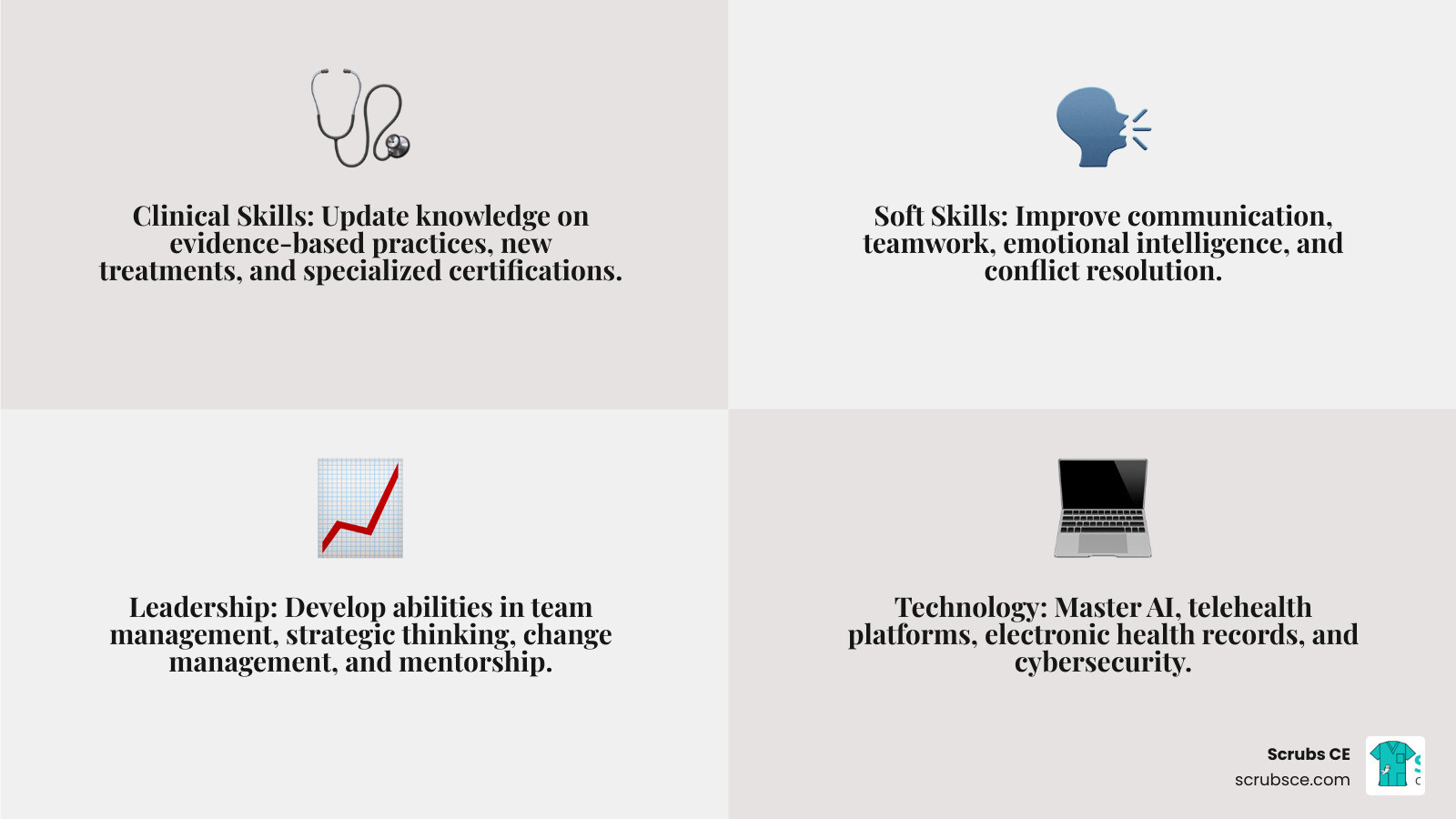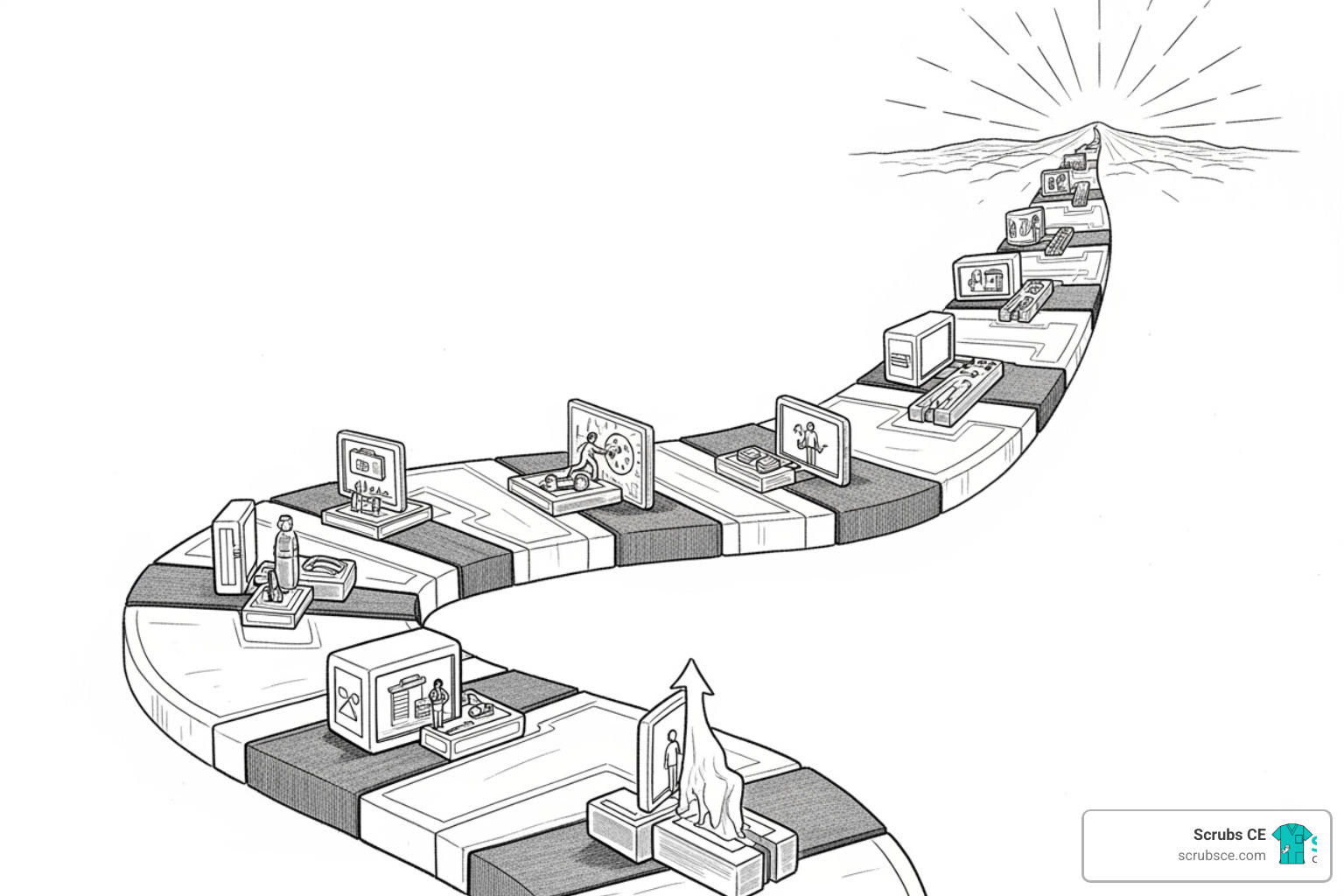Why Professional Development Healthcare Matters More Than Ever
Professional development healthcare is the continuous learning healthcare professionals engage in throughout their careers, extending far beyond an initial degree or license. It includes:
- Clinical Skills Updates – Staying current with evidence-based practices.
- Soft Skills Training – Improving communication, conflict resolution, and patient interaction.
- Leadership Development – Building team management and decision-making skills.
- Technology Proficiency – Mastering AI, telehealth, and electronic health records.
- Regulatory Compliance – Meeting continuing education (CE) requirements.
In today’s rapidly evolving healthcare landscape, skills become outdated quickly. It takes an average of 14-17 years for new medical evidence to be broadly implemented—a gap professional development aims to close.
The stakes are high, with an estimated 33% of new nurses leaving the profession in their first year. This workforce crisis makes continuous learning and career satisfaction more critical than ever.
Professional development isn’t just about maintaining a license; it’s about advancing your career, improving patient outcomes, and finding fulfillment. As Jimmy Chung, Chief Medical Officer at Advantus Health Partners, notes: “All healthcare careers now require a level of proficiency in health IT.” Fortunately, opportunities from flexible online courses to hands-on workshops are more accessible than ever.
What is Professional Development in Healthcare?
Think of professional development healthcare as a personal commitment to continuous growth. As technology, treatments, and patient expectations evolve, professional development is how you keep pace. The Association of American Medical Colleges (AAMC) defines continuing professional development as activities integrated into daily work life that enable professional growth.
Unlike initial training, professional development is learner-driven. You set your goals and choose your path on a career-long journey that adapts to your needs and the changing healthcare landscape.
Defining the Scope: More Than Just Clinical Updates
Successful professional development goes beyond clinical procedures. It involves building soft skills like communication and leadership to handle difficult conversations and guide teams. It also includes Diversity, Equity, and Inclusion (DEI) training for culturally sensitive care and a focus on physician wellness and burnout management. This is about upskilling for the real world—gaining new competencies and leadership qualities to be a proactive, well-rounded caregiver.
Professional Development vs. Continuing Medical Education (CME)
While often used interchangeably, these terms have different meanings. Continuing Medical Education (CME)—or Continuing Education (CE)—focuses on the clinical knowledge required to maintain licensure and meet regulatory requirements (e.g., 12 annual credits for a physician in Alabama, 5-15 contact hours for a nurse).
Professional Development (PD) is the bigger picture. It includes CME but also encompasses non-clinical skills like leadership, conflict management, and career planning. In short, CME is often about what you need to know, while PD is about how you apply it and who you become as a professional.
| Feature | Continuing Medical Education (CME)/CE | Professional Development (PD) |
|---|---|---|
| Scope | Narrower, often clinical or technical | Broader, encompasses clinical, non-clinical, and personal growth |
| Focus | Maintaining competence, updating knowledge | Enhancing overall capabilities, career advancement, holistic growth |
| Driver | Often regulatory/licensure requirements | Learner-driven, career goals, organizational needs, passion for growth |
| Outcome | Compliance, updated clinical skills | Improved performance, leadership, job satisfaction, career progression |
Many courses, like those at Scrubs CE, fulfill CE requirements while contributing to your broader professional growth. See how CE fits into your career in our Guide to Continuing Education for X-Ray Technologists.
The Transformative Benefits of Lifelong Learning
Professional development healthcare is transformative for you, your patients, and your entire healthcare system. Investing in your learning creates a positive chain reaction: you become more confident, patients receive better care, and your workplace grows stronger. It’s a win-win-win. For a deeper look at this in radiology, see our article: 5 Benefits of Continuing Radiology Education.
For the Professional: Career Growth and Satisfaction
Continuous learning makes work more engaging. By mastering new skills or developing leadership qualities, you keep the spark alive in your career. Professional development also creates valuable networking opportunities at conferences or in online forums, building a professional support system. The impact on job satisfaction is significant. Feeling challenged and valued leads to increased employee retention and reduced turnover, which is crucial in a field where burnout is high. We’ve written about this for radiologic technologists here: 7 Ways Radiology CE Can Benefit You.
For the Patient: Enhancing Safety and Quality of Care
Your professional development improves patient safety and quality of care. Research shows it takes 14 to 17 years for new medical evidence to be widely used in practice. Professional development closes that gap, ensuring patients benefit from the latest research. The landmark 1999 IOM report “To Err is Human” highlighted the problem of preventable medical errors, an issue that ongoing education directly addresses by keeping professionals current on best practices. Furthermore, training in health equity and cultural sensitivities ensures all patients receive respectful, appropriate care that honors their individual backgrounds.
For the Health System: Building a Resilient Workforce
High turnover is a painful reality for healthcare organizations. With 33% of new nurses leaving in their first year, the costs of recruitment and lost knowledge are immense. Professional development is a powerful tool for reducing staff turnover. When employees feel invested in, they are more likely to stay, seeing a future for themselves in the organization. A continuously learning workforce is also more adaptable to new technologies and protocols, which improves system performance. While training requires an upfront investment, it generates significant cost savings compared to the expense of constant staff replacement. Our article on The Importance of Continuing Education (CE) for X-Ray Technologists explores how this strengthens entire teams.
Navigating Your Growth: Types of Professional Development Training
Finding the right professional development healthcare opportunity is easier than ever, with a variety of formats to fit your schedule and learning style. The modern toolkit includes everything from online courses and hands-on workshops to conferences, mentorship programs, and clinical simulations. The key is to find what fits your career aspirations.
Flexible and Accessible: Online Learning and E-Courses
For busy professionals, online learning is a game-changer. On-demand, self-paced study means you control when and where you learn, without the pressure of a fixed schedule. You can pause, rewind, and review material as needed. Virtual webinars bring experts to your screen, and many are recorded for later viewing. Online platforms are also highly cost-effective, eliminating travel and lodging expenses. This accessibility breaks down geographical barriers, bringing specialized training to everyone. At Scrubs CE, our platform is built on this principle—providing high-quality, affordable courses that fit into your real life. For a look at your options, check out The Top X-Ray Radiology CE Credits You Can Earn Online.
Hands-On and Collaborative: Workshops, Conferences, and Mentorship
While online learning offers flexibility, in-person and collaborative formats provide unique benefits. In-person conferences expose you to cutting-edge research and valuable networking opportunities. Hands-on workshops and clinical simulations allow you to practice new skills in a supportive, low-risk environment—like a flight simulator for healthcare. Mentorship programs offer personalized guidance from experienced professionals, accelerating your growth with hard-won wisdom. Finally, peer-to-peer learning in journal clubs or study groups builds a community of practice. As a report from the National Academies Press on Continuing Professional Development: Building and Sustaining a Quality Workforce highlights, a blend of these diverse methods creates a well-rounded, resilient workforce.
The Evolving Landscape of Professional Development Healthcare
The journey of professional development healthcare is one of constant evolution, shaped by technology and our growing understanding of excellent patient care. Understanding this evolution helps us prepare for the future.
From Past to Present: A Brief History and Current Trends
The idea that healthcare professionals should never stop learning has deep historical roots, from Florence Nightingale’s advocacy in the 1800s to the post-WWII boom in formal continuing medical education. Early frameworks like the 1910 Flexner Report laid the groundwork for today’s evidence-based standards.
Today, the landscape is being transformed by several key trends. Artificial intelligence is revolutionizing diagnostics and treatment, while the expansion of telehealth demands new skills in remote care. Data analytics has become essential for quality improvement, and interprofessional education is gaining ground to improve team-based care. This has led to a shift toward personalized learning custom to individual needs. To learn more, see our article on 5 Trends Transforming Radiology Continuing Education You Need to Know.
Overcoming Barriers to Effective Professional Development in Healthcare
Despite its importance, pursuing professional development healthcare has its challenges. Common barriers include time constraints due to demanding schedules, the cost of courses and conferences, and a lack of organizational support. Many also feel overwhelmed by information overload.
Fortunately, solutions are emerging. Integrated learning embeds education into daily workflows, while microlearning delivers content in short, manageable bursts. Organizational support, such as protected learning time and financial assistance, is crucial. For individuals, flexible online platforms like Scrubs CE offer an affordable, self-paced solution. We’ve even streamlined the process, as explained in our guide: How to Enroll in X-Ray CE Fast.
The Future of Professional Development in Healthcare
The future of professional development healthcare is exciting. Personalized learning paths, powered by AI, will tailor content to your specific needs and goals. Virtual and augmented reality (VR/AR) will offer immersive, risk-free training for complex procedures. Gamification will make learning more engaging and effective. Crucially, there is a growing focus on workforce well-being, with programs increasingly including training on resilience and burnout prevention. This all points toward a true lifelong learning culture, where growth is an integral part of professional identity and excellent patient care.
Fostering a Culture of Growth: The Role of Organizations and Regulators
A thriving environment for professional development healthcare requires a partnership between motivated individuals, supportive organizations, and clear regulatory bodies. When these three elements work together, continuous learning becomes a cornerstone of quality care.
How Healthcare Organizations Can Champion Staff Development
Organizations have the power to foster a culture of growth. The most effective strategies include:
- Providing Resources: This means not just funding for training but also offering protected learning time so staff can develop skills without being overwhelmed.
- Implementing Mentorship Programs: Connecting experienced professionals with those earlier in their careers transfers invaluable knowledge and provides guidance.
- Encouraging Personal Development Plans (PDPs): These plans help align individual career aspirations with organizational goals, creating a clear path for growth.
- Fostering a Learning Culture: Beyond formal programs, leaders must create an environment where curiosity is celebrated, knowledge-sharing is routine, and learning from mistakes is encouraged.
The Influence of Regulatory and Professional Bodies
Regulatory and professional bodies set the standards for professional development healthcare. State licensing boards establish mandatory continuing education (CE) requirements, which can vary significantly by state and profession. (For example, we help professionals steer these rules in our guide, How Many X-Ray CE Credits Do I Need for Radiography?).
Accreditation councils like the Accreditation Council for Continuing Medical Education (ACCME) ensure that CE courses meet rigorous quality standards. Finally, professional organizations such as the Association of American Medical Colleges (AAMC) and the Healthcare Information and Management Systems Society (HIMSS) advocate for lifelong learning policies and define best practices, bridging the gap between regulatory mandates and the needs of working professionals.
Frequently Asked Questions about Professional Development
Here are answers to some common questions about professional development healthcare.
How is professional development different from the training I received in school?
Your initial schooling provided the foundation. Professional development healthcare is the lifelong process of upgrading and expanding on that foundation. Healthcare evolves rapidly with new research, technologies, and standards of care that differ from what you learned in school. Professional development keeps you current, allows you to specialize, and helps you translate knowledge into the practical skills needed for evidence-based patient care.
How do I find the right professional development opportunities for my career goals?
Start with a self-assessment of your strengths, weaknesses, and long-term goals. A personal development plan (PDP) can help map out the skills you need. Consult your professional association for recommended courses and career pathways. Explore online platforms like Scrubs CE for a wide range of accredited, self-paced courses. Finally, network with peers and mentors for valuable insights and recommendations. For more on this, see our guide: How to Use Continuing Education to Advance to a Different Modality Within Radiology.
Can I get CE credits for professional development activities?
Yes, many professional development activities offer CE credits. The key is to ensure the activity is accredited by a body recognized by your profession’s licensing board (e.g., ACCME for physicians, ASRT for radiologic technologists). Always verify that the credit type is accepted by your board and be sure to document your learning by keeping all certificates for renewal. At Scrubs CE, our courses provide the necessary accreditation to help you confidently earn your required credits. Learn more here: CE Credits for Radiology: How Can I Get Them?.
Take the Next Step in Your Healthcare Career
Healthcare never stands still. Every day brings new research, new technologies, and new challenges that shape how we care for our patients. In this dynamic environment, professional development healthcare isn’t just about checking boxes or maintaining your license—it’s about embracing growth as a core part of who you are as a professional.
Throughout this guide, we’ve explored how continuous learning transforms careers, lifts patient care, and strengthens entire healthcare systems. We’ve seen how it bridges the gap between new evidence and everyday practice, how it combats burnout and turnover, and how it opens doors you might not have known existed.
The truth is, taking ownership of your professional growth is one of the most empowering decisions you can make. When you commit to lifelong learning, you’re not just adapting to change—you’re staying ahead of it. You’re positioning yourself to thrive in new roles, master emerging technologies, and find renewed purpose in your work. You’re becoming the kind of professional who doesn’t just react to the healthcare landscape, but actively shapes it.
We know your time is precious and your schedule is demanding. That’s why we created Scrubs CE—to make high-quality continuing education accessible, affordable, and convenient for busy healthcare professionals like you. Our self-paced online courses fit around your life, not the other way around. You get instant certificates, clear credit tracking, and the knowledge you need to not only meet licensure requirements but genuinely advance your career.
Whether you’re looking to fulfill your CE requirements, explore a new specialty, or simply stay at the top of your game, we’re here to support your journey every step of the way.
Ready to invest in yourself? Explore our full range of radiology CE courses and take the next step in your healthcare career today.






Recent Comments